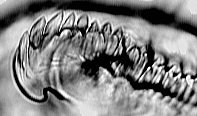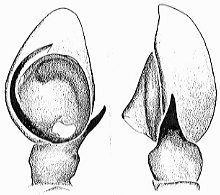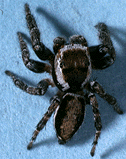Plexippinae
Wayne Maddison- Bianor
- Brancus
- Dexippus
- Evarcha
- Harmochirus
- Hyllus
- Mogrus
- Paramodunda
- Plexippoides
- Plexippus
- Telamonia
- Thyene
- Yaginumella
Introduction
The plexippines are among those salticids with the embolus immovably fixed to the tegulum. They occur primarily in the Old World, and include some of the more familiar genera (Plexippus, Evarcha, Hyllus, Thyene). The genus Bianor probably does not belong technically within the group, since the type species is apparently not a plexippine. However, some of the more familiar species (e.g. B. aenescens and aemulus) are plexippines and may very well deserve a transfer to Harmochirus.
Characteristics
Characters delimiting the Plexippinae are (Maddison, 1996):- Male endite serrula with the most lateral few teeth curled and projecting:
 Click on an image to view larger version & data in a new window
Click on an image to view larger version & data in a new window
Ventral view of lateral edge of endite serrula of male Evarcha.
- Males with a bump on the tegulum near the base of the embolus. The bump is just counterclockwise to the embolus and points clockwise on a left palp. Heliophanines also have bump on the tegulum but it is in a different place.
 Click on an image to view larger version & data in a new window
Click on an image to view larger version & data in a new window
Left palpus of Bianor aemulus
- Tufts of setae occur near eyes, reminiscent of those of Phidippus. Those of plexippines occur below the small eyes and between the PME and ALE, while those of Phidippus occur below the PME and between the PME and PLE. This tuft character may help support the grouping of plexippines, but it does so only weakly, for a number of species in the group lack distinct tufts, including Bianor aemulus and some species of Evarcha.
References
Maddison, W.P. 1996. Pelegrina Franganillo and other jumping spiders formerly placed in the genus Metaphidippus (Araneae: Salticidae). Bulletin of the Museum of Comparative Zoology. l54(4): 215-368.
Title Illustrations

| Copyright |
© 1994-1995 Wayne Maddison

|
|---|
About This Page
Wayne Maddison

University of British Columbia, Vancouver, British Columbia, Canada
Correspondence regarding this page should be directed to Wayne Maddison at
Page copyright © 2011 Wayne Maddison
All Rights Reserved.
Citing this page:
Maddison, Wayne. 1995. Plexippinae. Version 01 January 1995 (under construction). http://tolweb.org/Plexippinae/2847/1995.01.01 in The Tree of Life Web Project, http://tolweb.org/








 Go to quick links
Go to quick search
Go to navigation for this section of the ToL site
Go to detailed links for the ToL site
Go to quick links
Go to quick search
Go to navigation for this section of the ToL site
Go to detailed links for the ToL site